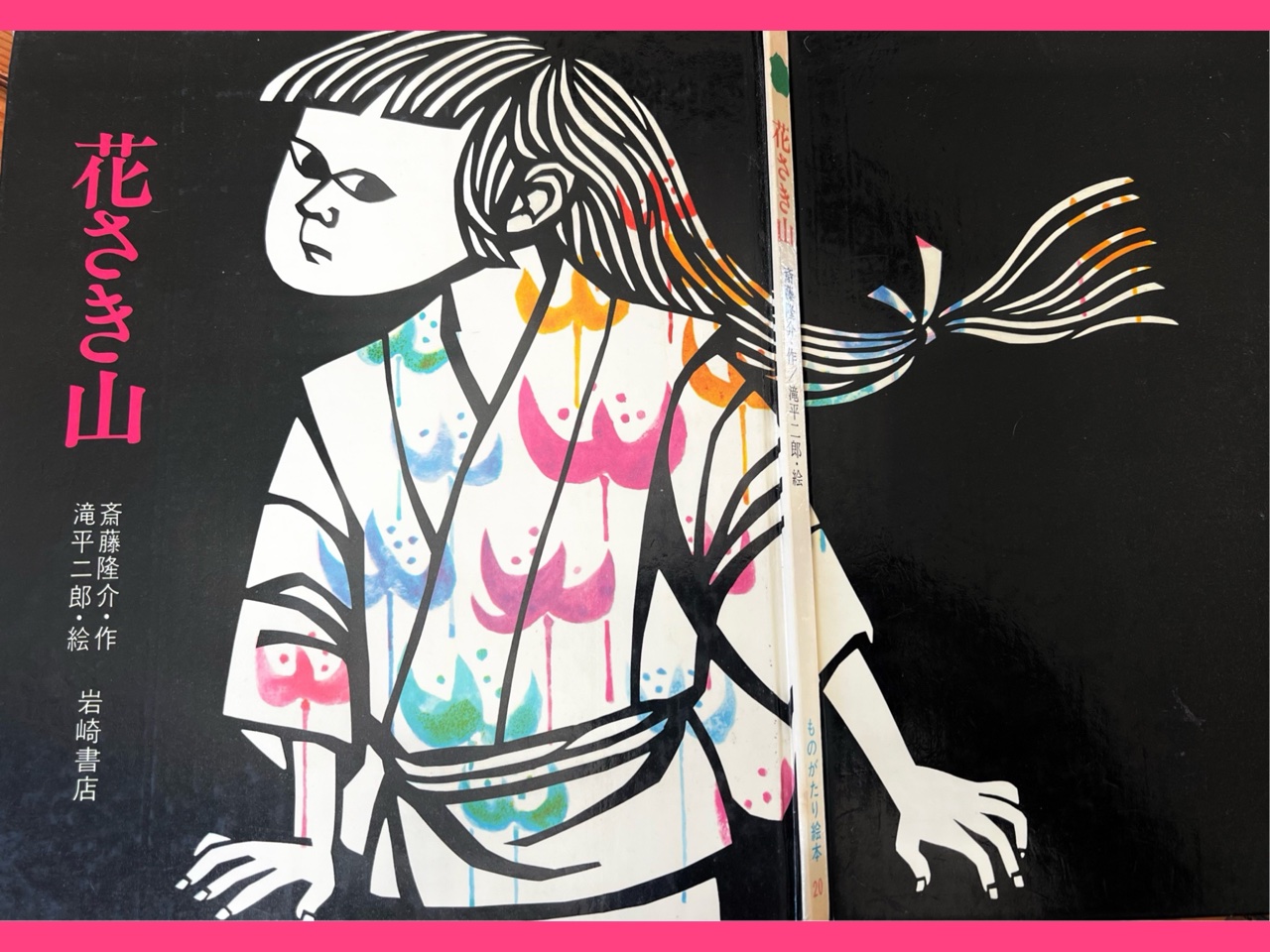
My Favorite Japanese Picture Book
One of my favorite Japanese picture books is "Hanasakiyama - Flowering Mountain," written by Saito Ryusuke and illustrated by Takidaira Jiro. I admire Saito Ryusuke's storytelling, and Takidaira Jiro's artwork is truly captivating. As a cut-paper artist myself, I draw immense inspiration from Takidaira Jiro's work, particularly his woodcut prints.
I began reading picture books by myself when I was around 2 and a half or 3 years old, but, I was only pretending to read at the time. Over the years, as I gained a deeper understanding of writing systems, my love for reading grew. I was drawn to the rich narratives in Saito and Takidaira's collaborations.
Their partnership is truly remarkable. The seamless integration of story and artwork in their books is incredibly impactful. Many of their stories leave a lasting impression, characterized by vivid imagery and profound themes. "Hanasakiyama - Flowering Mountain" is no exception, with its poignant and gentle narrative that delves into profound depths.
During a recent trip back to Japan, I rediscovered this cherished picture book. However, instead of keeping it for myself, I decided to donate it to someone who shares my passion for reading. As a tribute to this beloved book, I've chosen to write about its story in a memorial blog post.
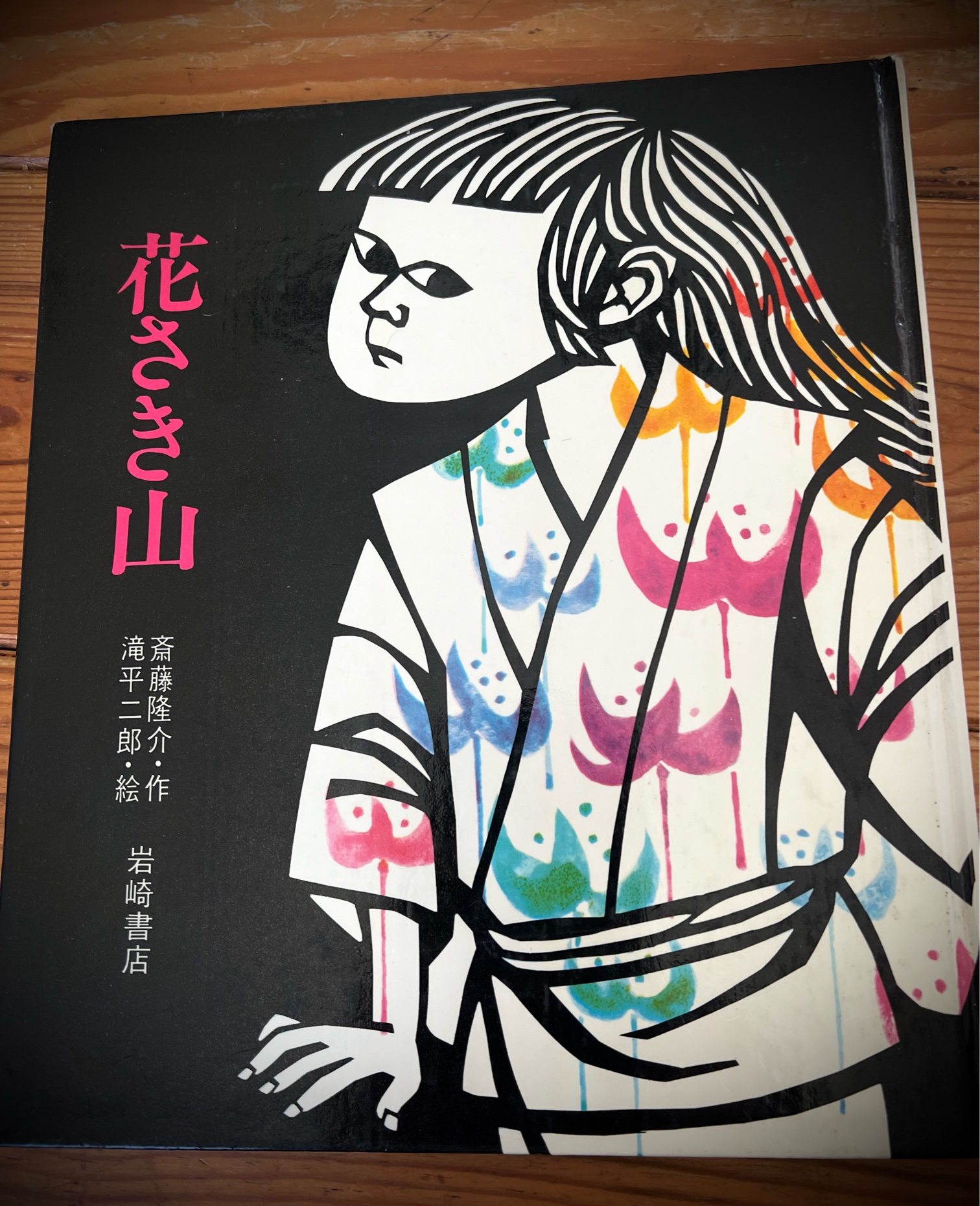
I love the front cover. The title pops up against a black background. The girl, Aya, is the main character of this picture book. I adore the flower patterns on her kimono dress and in her hair. She appears a little bit sad on this front cover.
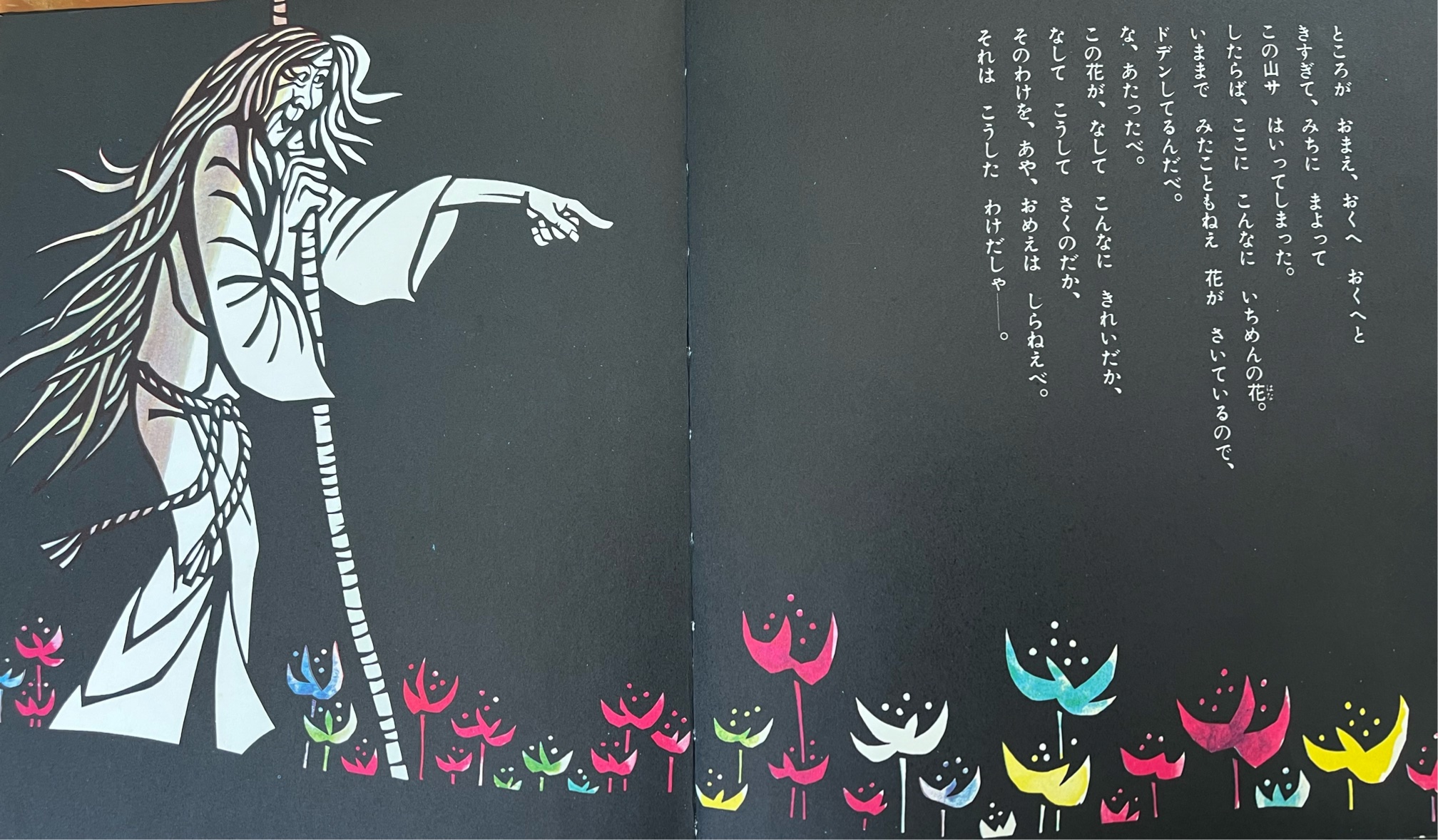
When I turned the page, the image of the old lady Yamanba (a mountain hag) shocked me, and I've never forgotten it since. Surprisingly, Yamanba is not a frightening character at all. She possesses deep knowledge about our lives and the world around us. One day, when Aya gets lost in the mountains, she encounters Yamanba.
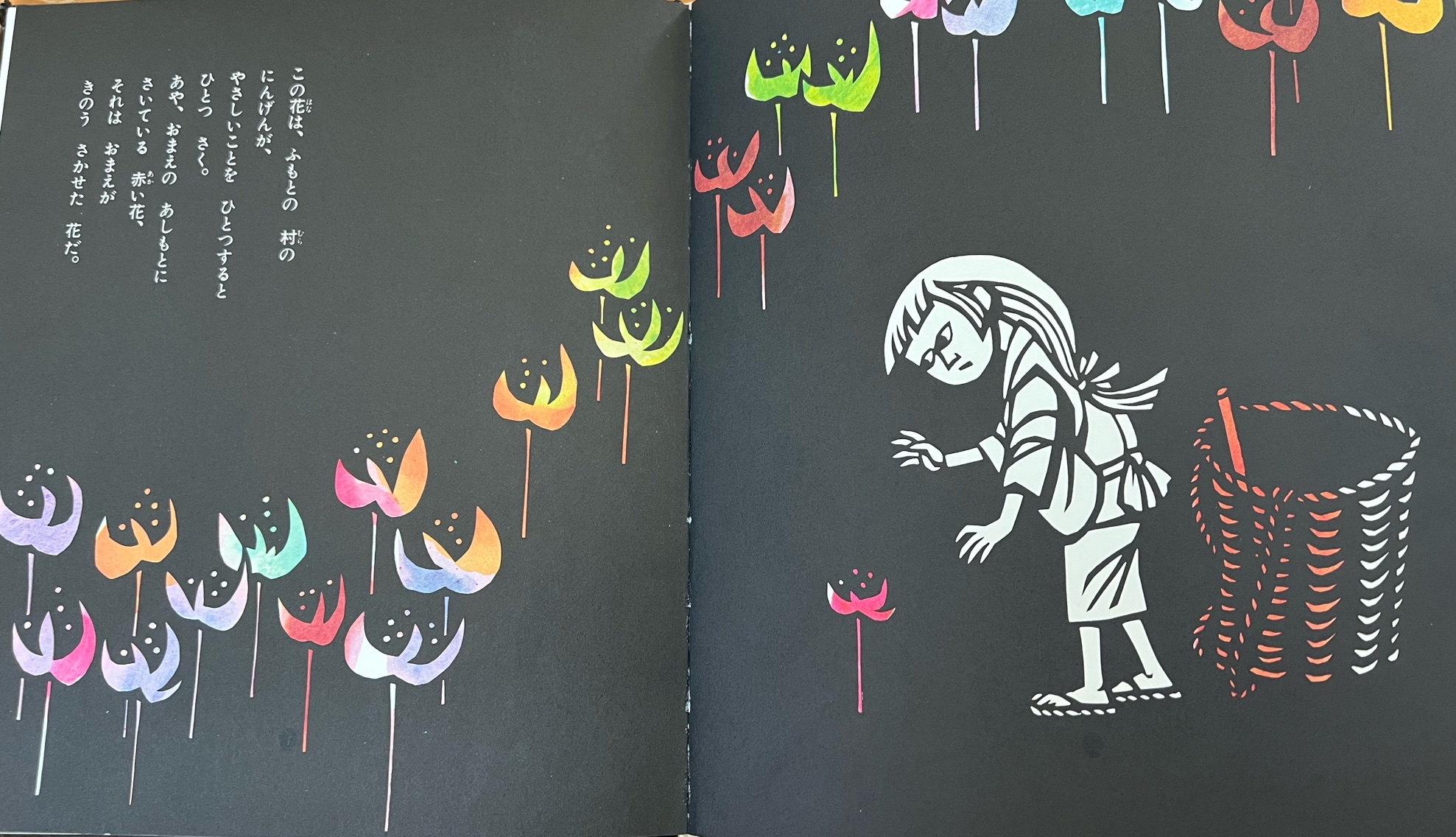
Yamanba told Aya that these beautiful flowers were created and bloomed by someone who tried so hard to stand something with their gentle mind. Aya was recently very patient with her younger sister. Yamanba showed her that a small red flower was created by Aya.
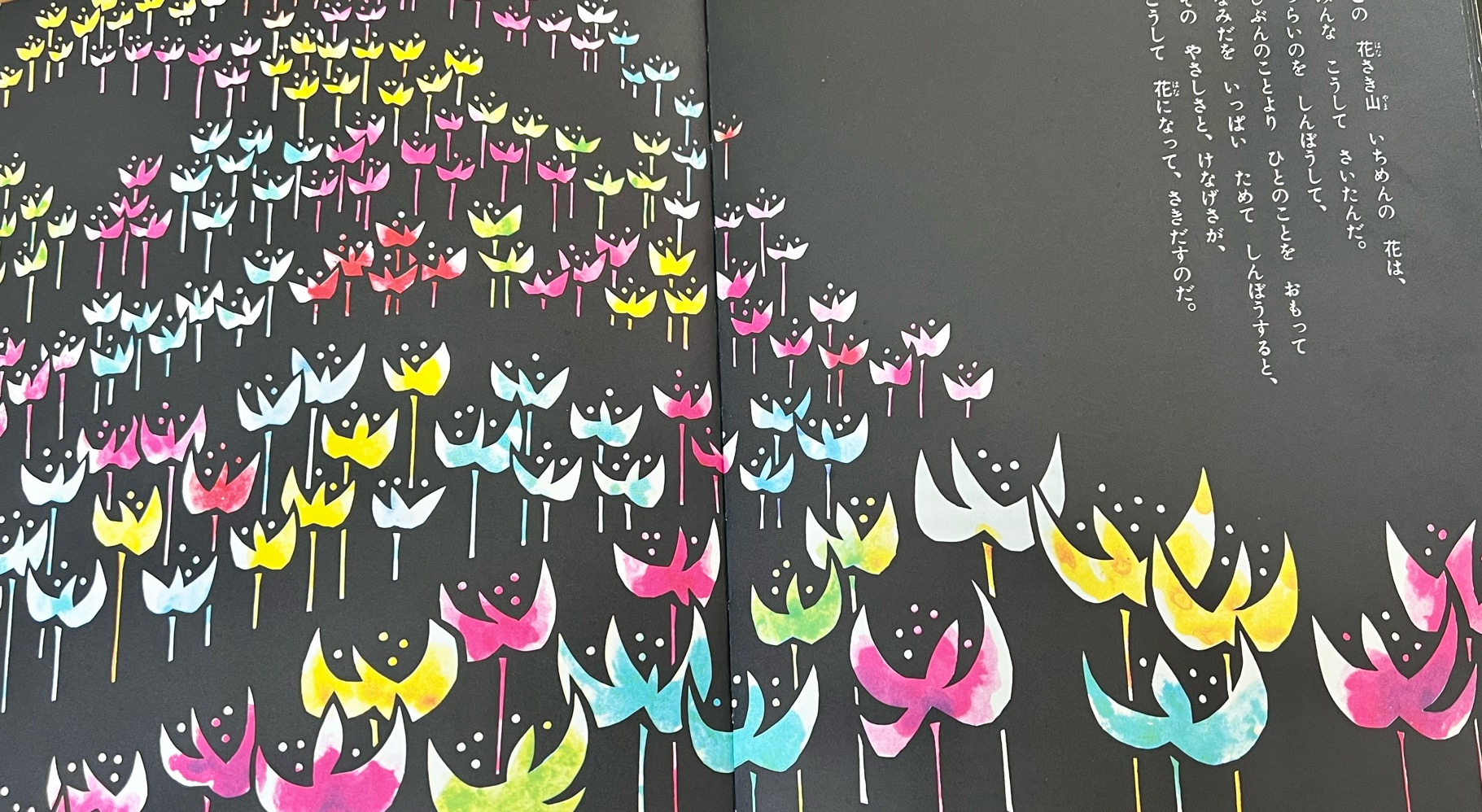
Aya was facing her initiation, I guess. Being patient is a very challenging task for almost everyone. However, through Aya's eyes, we notice that many beautiful flowers bloom through everyone's effort and gentleness.

This simple and beautiful picture and sentence left a profound impact on me. This morning's dew is actually someone's tear. There were times when I struggled with life, challenged to understand our society and the material world. This picture book somehow treated, healed, and comforted me.
Even now, after growing up, I sometimes find it difficult to read this book straight away. I need a quiet moment and a safe space to immerse myself in its delicate story.
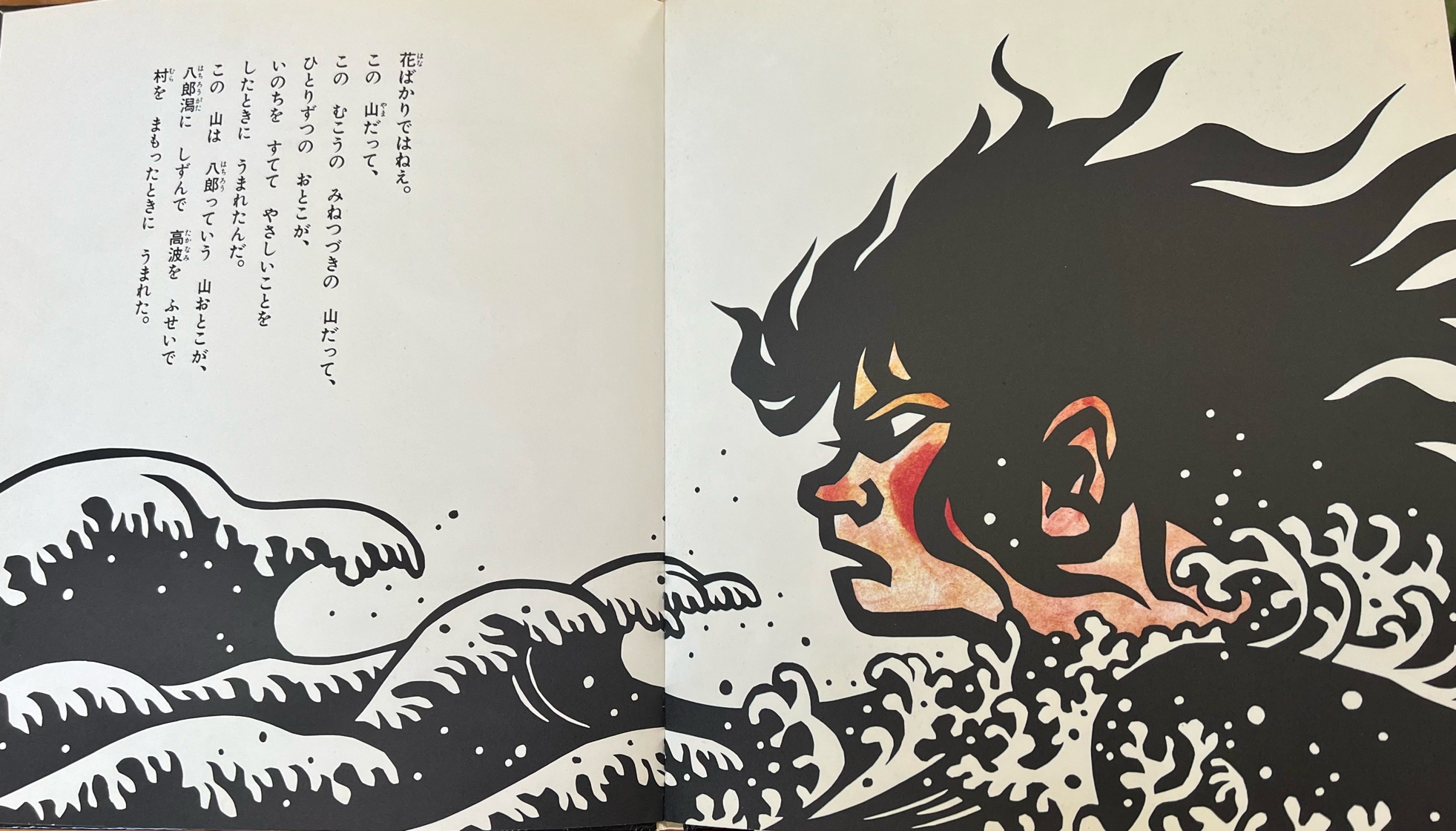
This scene had a huge impact as well. Yamanba was explaining to Aya that there were many people who tried for others and the world. For instance, the giant man Hachiro Gata sacrificed himself to save people from tsunami waves. Hachiro Gata is the actual name of a lake in Japan. This story provided me with insight into the history of tsunamis and natural disasters.
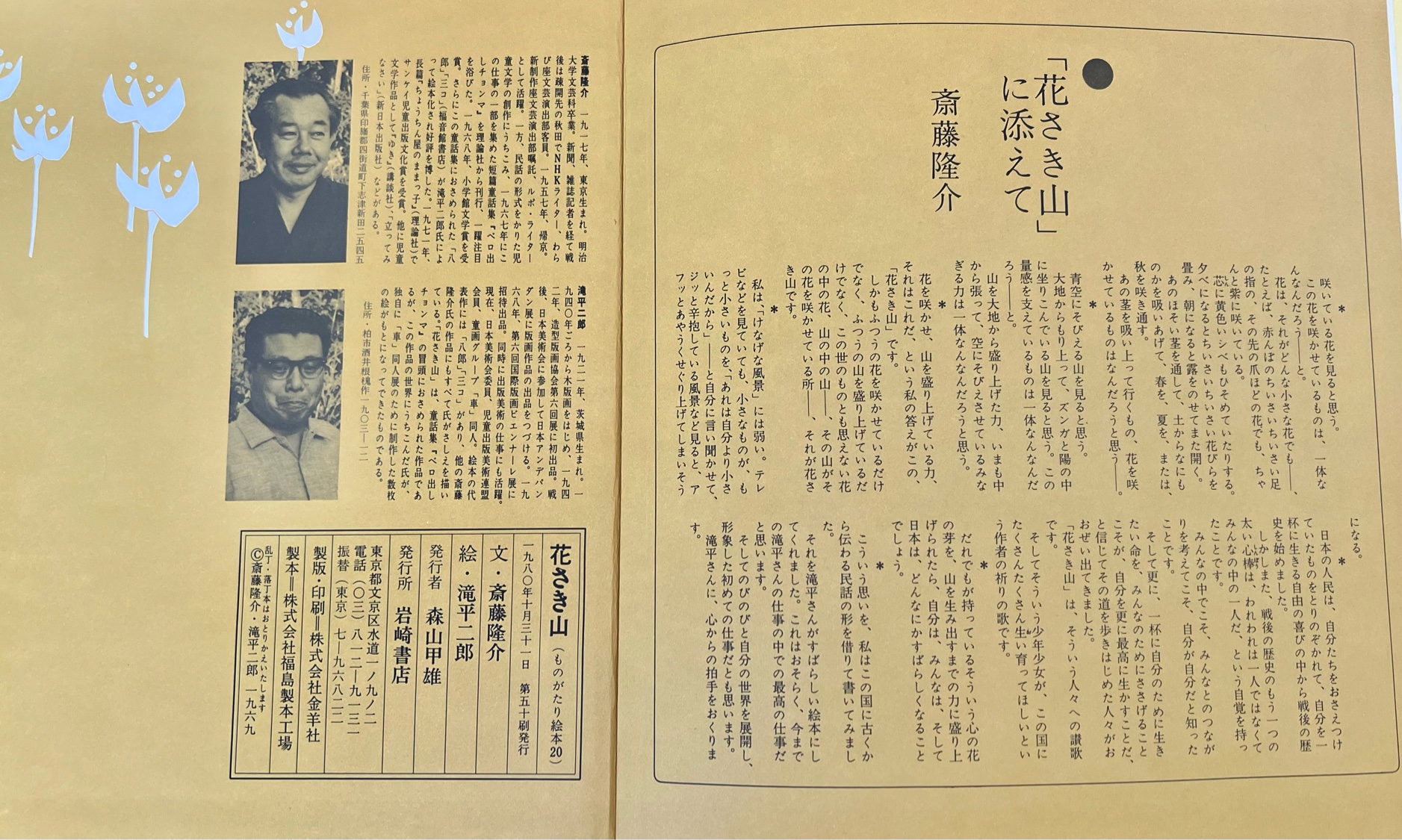
This is the last page of the picture book. I read the author's afterword many times, which contains a beautiful message from the author to future children. There is hope and a strong message about peace conveyed through the explanation of Japanese culture and nature.
The author also mentioned the concept of 'Kenage' (健気), a Japanese word that doesn't have a direct translation in English. Kenage describes individuals who persevere despite facing difficulties, embodying traits of hard work and patience. I believe Aya is a symbol of Kenage.
I noticed that I had written my signature on the left side of this page, which I edited out for this blog. I'm not entirely sure why I wrote my name on this page. Perhaps I felt the need to internalize some lessons from this book, as Japanese students often write their names in their books. Or maybe I simply liked this book. Interestingly, my favorite Japanese subject teacher also admired this author and artist. Somehow, I felt proud of owning this book. Anyway, I truly appreciate this book.
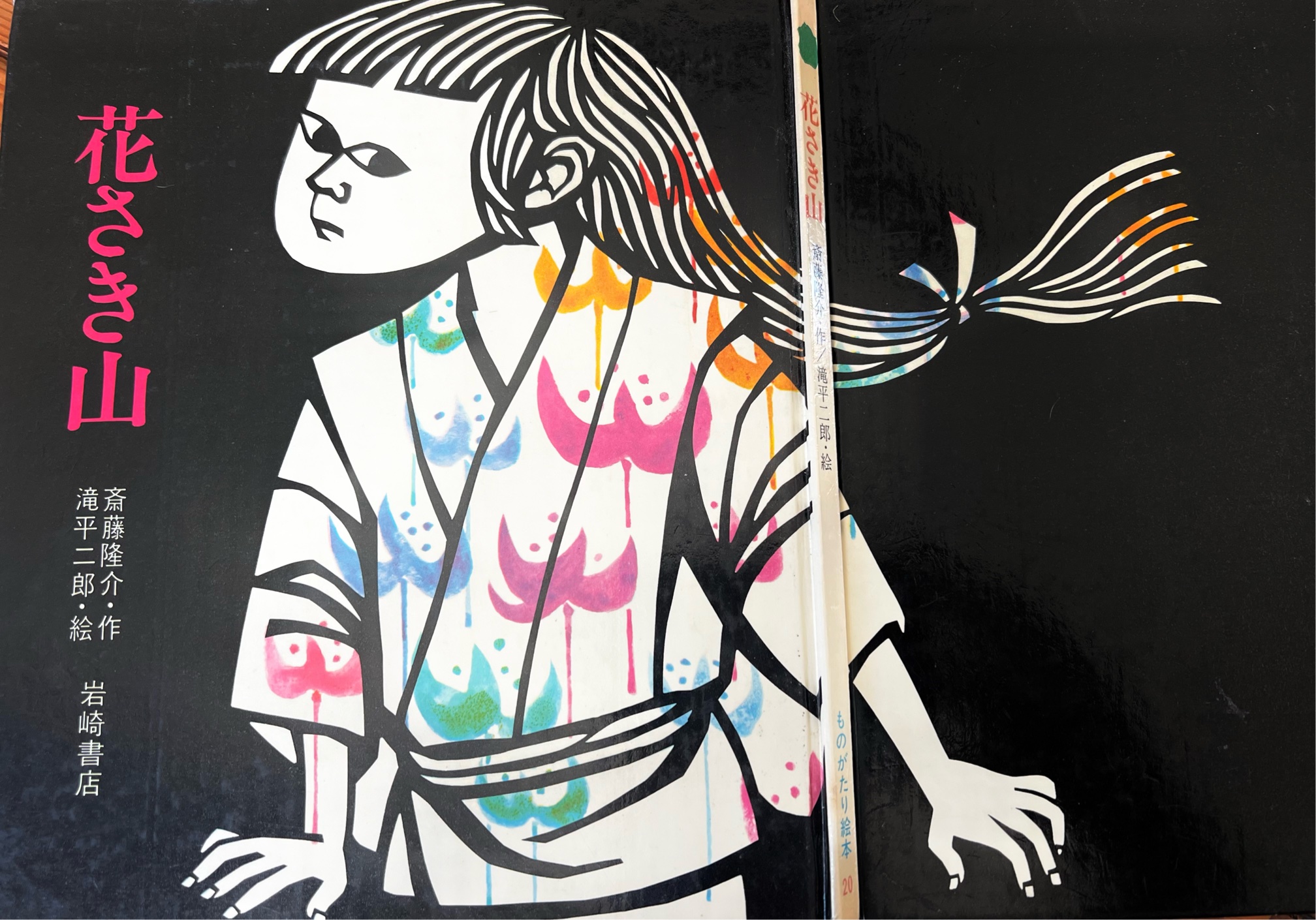
If I open the book widely like this, you can see the whole beautiful artwork. Aya's hair is floating in the air. Interestingly, after reading this book, Aya's face on the front cover no longer looks sad. She exudes confidence after completing her journey. Similarly, the reader gains confidence after immersing themselves in the story. I wonder if I graduated from this picture book this time I guess.

Japanese 日本語

私の好きな日本の絵本
これは私が好きな絵本「花さき山」です。斎藤隆介氏作、滝平二郎氏の挿絵です。斎藤隆介氏の素敵なお話とともに滝平二郎氏の素晴らしいアートに魅了されます。滝平二郎氏の切り絵と版画に憧れたことが私が切り絵を作るひとつのきっかけでもあります。
2歳半から3歳くらいにかけて自分で絵本を読むという行動を始めた記憶があります。とは言っても、ただ読んでいる真似ごととするだけでした。それから徐々に文字を覚えてひとりで読むことができるようになってきました。斎藤氏と滝平氏の共同作品にはかなり惹かれました。
おふたりの絵本は本当に素晴らしい作品ばかりです。物語とアートが見事に織り混ざってインパクトのある絵本になっています。どの作品も印象的な絵本ばかりで、想像力豊かな話の中の華やかな登場人物たちが繰り広げる物語は、忘れることなく記憶の中に残っています。中でも私が特に好きなのは大変優しい絵本である「花さき山」です。
以前日本に帰国した際、実家に残っていた絵本を改めて読み直してみました。その中から花さき山だけを持ち帰ってきました。もう何度も何度も読んできたこの本を今回は寄付することにしましたので、ブログに思い出として綴っておくことにしました。

絵本の表紙がたいへん素敵です。まっ黒の背景にピンクの題名がとても映えます。この少女、あやは物語の主人公です。着物と彼女の髪の毛に映る花柄がとても綺麗です。あやの表情は少し悲しそうに見えます。

ページをめくるとやまんばの姿が目に飛び込んできて、初めて読んだ時はかなりのインパクトだったのを忘れることができません。このやまんばの性格は全く醜くはありません。彼女は人間の人生や社会のことをなんでも知っています。ある日、あやが山で道に迷ってしまい、このやまんばに出会します。

やまんばは、優しい心を持って何かに耐え忍んだ者がいるからこそ花たちが咲き乱れるのだということをあやに教えました。あやはちょうど妹のために優しい我慢をしたばかりでした。やまんばはそこに咲いている小さな赤い花があやの花だということを教えてくれました。

あやは通過儀礼のようなものを迎えているのではないかと、私は想像しました。我慢強くいることは誰しもが直面する大変難しい局面です。しかし、努力と優しさで美しい花を咲かせることができるのだということを、あやの目線を通じて読み手は気づかされるのだと思います。

この素朴で美しい絵と文章はかなり印象深かったのを覚えています。 花の上に落ちたこの朝露は、誰かさんの我慢の涙です。人は人生につまづいてしまった時、社会や物質世界での暮らしがどうしていいかわからなくなってしまうほど何かを見失ってしまうこともあるのではないでしょうか。そんな時、この絵本が自分を優しく治癒してくれて心地よさを取り戻させてくれるような気がしていました。
大人になってから読み直そうと思ってページを開いても、なかなか苦しい気持ちになって読めないこともありました。そんなときは静かな安全な場所を確保して、じっくり目を通す必要がありました。

この場面もかなり印象的です。やまんばはあやに世界中で努力している人がいることを教えました。この大男は八郎潟と言って津波から人々を救った男です。八郎潟は実際に日本にある湖ですね。この本を読んで、日本には昔から自然災害による津波の被害があるのだということをまざまざと学びました。

これは最後のページです。作者の後書きを幾度となく読み返しました。後書きには作者の素晴らしい思いである、未来の子どもたちへ送る言葉が書き綴られています。そこには日本の文化と自然を通じて平和への希望と強いメッセージが込められています。
さらに、作者は「健気」という日本の言葉についても触れています。あやは健気の象徴なのではないかと私は思います。
写真を撮るときに写らないようにしましたが、この最後のページには左端に私の名前が書いてありました。なぜ自分の名前を記載したのかは記憶にありませんが、おそらくこの本からたくさんのことを学んだのでその思いを込めて自分の名前を記入したのか、またはただ単に日本の学生特有の教科書などに名前を書くという作業をしただけなのかはわかりません。単純にこの本をとても気に入ったからなのかもしれません。面白いことに、私の好きだった恩師である国語が専門の小学校の先生もこの作者とアーティストさんが好きでした。私はこの絵本を持っていることを誇りに思っていました。とにかくたくさん感謝の思いがあります。

絵本をこうして見開きにすると、美しい絵の全貌が見えます。あやの髪の毛が風になびいています。興味深いことに、この絵本を読み終えてから改めて表紙を眺めてみると、最初と違ってあやが悲しそうに見えません。あやはひとまわり大きくなって自信を持っているような表情に見えます。同様に、きっと読み手も絵本を読み終えると勇気づけられるような気がします。私は今回、この絵本から卒業できたのかもしれません。なんとなくそんな気がしています。

Thank you for reading!
お読みいただきありがとうございます。
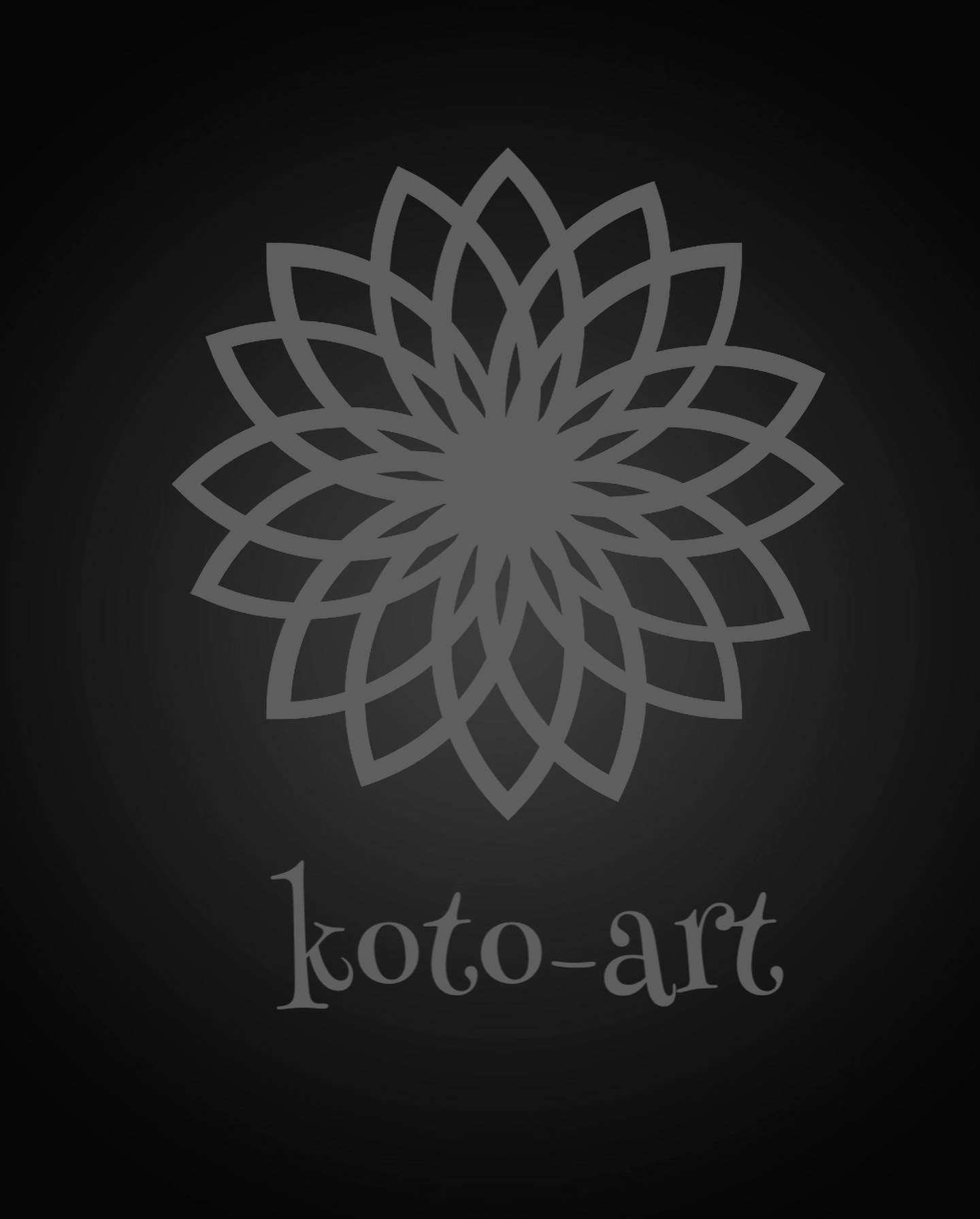
Nice Picture ❤️
Keep up the good work 👍🏼
Thank you so much!
素晴らしい〜!!懐かしいです!「花さき山」!
山姥の登場するページを見て、一気に記憶が蘇り「そうそう、この中にお前の咲かせた花があるって教えてくれるんだった!」と思い出して、小学校の図書室で読んだことが懐かしかったです。
「八郎潟」のページも鮮明に思い出すことができました。
背景が黒一色なので、そこに咲く色とりどりの花がとても印象的ですが、暗い山へこれから自分自身が実際に入っていくような心情が強烈にリンクして、読み進めるのに勇気が必要だった記憶があります。
この絵本はコトさんの切り絵のライフワークの原体験のひとつなのですね。
次にこの絵本を手に取ってくれる人それぞれに心に残る場面が違うと思いますが、コトさんの記事にある通り「社会や物質世界での暮らしがどうしていいかわからなくなってしまうほど何かを見失って」しまった時に、生きる指針になると感じました。
懐かしいですよね〜。モチモチの木も素敵ですが、自分にとっては花さき山の方が印象に残る一冊です。どんなすごい本よりも結局絵本がいちばん好きなのだと思います。@aitommylrさんがおっしゃっていたがまくんとかえるくんの絵本もそうですが、この時代に読んだ絵本のインパクトって強いですよね!
そうなんです、切り絵の素晴らしさに惹き込まれて影響受けまくりです。こんなにシンプルなのに存在感がありますよね。そうそう、暗い山に入っていく心情が読み手にすごく伝わってきますよね。絵本はアニメと違って動きませんが、頭の中で動きますものね。大人になった今でも読み聞かせのビデオを聞き流してたまに作業中に聞いています。でも、絵と話に惹き込まれて作業の手が止まっている自分がいます。笑
I like how you describe the beauty and impact of Takidaira Jiro's illustrations, which inspire you as a cut-paper artist. The way you describe your emotional connection to the book, how it has comforted you and taught you valuable lessons about patience, sacrifice and hope, is really touching. It is clear that this book has left a lasting impression on you over the years. ❤️
Thank you so much for your kind comment! Yes, Mr. Takidaira's artwork has inspired me a lot. His artwork is full of love and respect for nature, animals, and human life. I hope someone will find my book at a second-hand store and be able to read it with their parents or loved ones someday soon!